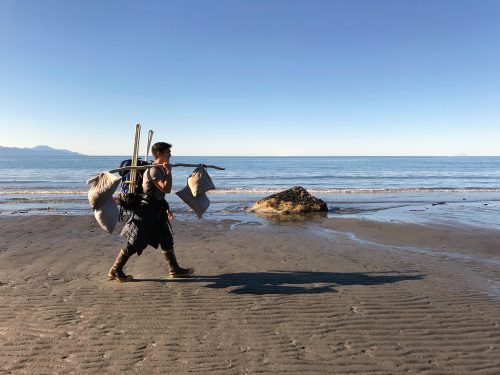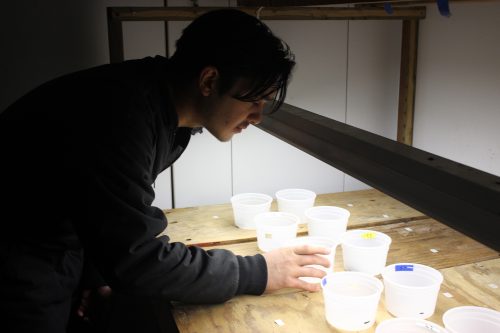Researchers delve into unexamined world of ¿÷ª¢÷±≤• seaweed
March 1, 2019
Lauren Frisch
907-474-5350

Growing up near the beach, Brian Ulaski often overlooked wrack, the seaweed that washes up on coastlines.
Later, as an undergraduate in California, Ulaski learned that wrack holds information about a coastline. It can tell us about the organisms that rely on this link between land and sea. Ulaski became interested in learning more about how wrack, and seaweed in general, can be integral to coastal ecosystems.
In ¿÷ª¢÷±≤•, few research projects have explored seaweed, even though there is growing interest in harvesting it for food and fertilizer. Now a graduate student at the University of ¿÷ª¢÷±≤• Fairbanks, Ulaski is part of a team taking some important first steps to determine whether seaweed and wrack can be harvested more broadly in Southcentral ¿÷ª¢÷±≤•.
Ulaski and UAF College of Fisheries and Ocean Sciences researcher Brenda Konar are looking at components that influence where and how seaweeds grow. They want to understand where seaweeds in Southcentral ¿÷ª¢÷±≤• thrive and whether more areas could support harvests, including take by commercial operations.
‚ÄúRight now, most coastlines in Southcentral ¿÷ª¢÷±≤• have nonsubsistence regulations that make it illegal to harvest live and growing seaweed ‚Äî whether attached, dislodged or even washed up on the beach,‚Äù Ulaski said. ‚ÄúWe don‚Äôt know if the regulations need to be so black and white. There are a lot of details that could determine whether certain species or areas of the coast could be sustainably harvested.‚Äù
Seaweed clusters provide a safe habitat for small fish and animals, and seaweed's abundant nutrients benefit both coastal and intertidal environments. Current harvesting regulations are in place because of this important role seaweed plays in the broader ecosystem.

Seaweed reproduction hasn't been studied much in ¿÷ª¢÷±≤•. More information would be useful so managers can ensure seaweed harvests do not harm the wild population. With funding from ¿÷ª¢÷±≤• Sea Grant, the Robert and Kathleen Byrd Award and the Northern Gulf of ¿÷ª¢÷±≤• Applied Research Award, Ulaski and Konar are seeking to answer long-standing questions about seaweed harvesting and reproduction.
‚ÄúThe current seaweed harvesting regulations in Southcentral ¿÷ª¢÷±≤• are conservative because we know very little about the local productivity of the species folks want to harvest in this area,‚Äù said Ted Otis, an area finfish research biologist for the ¿÷ª¢÷±≤• Department of Fish and Game. ‚ÄúBrian and Brenda‚Äôs project should help fill in some of those information gaps so we can assess if more harvest opportunity can sustainably occur.‚Äù
Using a combination of scuba and intertidal surveys and laboratory analysis, Ulaski is mapping the times of year that rockweed, sugar kelp and bull kelp reproduce in coastal waters. For some seaweeds, the reproductive season starts as early as March. On average, the ability to reproduce seems to ramp up as summer progresses. Some seaweeds die in the fall when this reproductive phase is complete, while others are able to last through the winter.
Understanding when and how quickly seaweeds are reproducing can provide some insight into appropriate harvesting timelines and quantities for different species. The amount of seaweed generally increases throughout the summer.
Ulaski also wants to know how quickly harvested seaweed can grow back. He harvested the same three types of seaweed from six different sites in Kachemak Bay, choosing three sites where regulations prohibit harvesting and three sites where subsistence harvest is allowed. The rates of regrowth varied by species, location and time.
Konar and Ulaski are among the first researchers to study ¿÷ª¢÷±≤•‚Äôs wrack. Because it primarily accumulates in the intertidal zone, wrack gets shifted around with tides, storms and wind. It can get pushed back into the ocean when conditions are more intense. Ulaski is studying the influence of these different variables on wrack movement.
“It’s not surprising that Brian is finding a pretty good correlation between wind speed and direction and wrack biomass,” Konar said. “This is helpful, because you can look at where the wind was blowing this week and have a pretty good understanding of where to expect wrack next week.”

Current regulations that prohibit harvesting live seaweed inspire some interesting philosophical questions about it. Is washed-up seaweed dead or alive? Konar and Ulaski will begin to answer that question by testing to see if wrack contains functional reproductive tissue.
This distinction matters for management purposes, Konar explained. Because wrack can be washed offshore and back into the ocean, there is a chance it will once again be able to contribute to the ocean’s gene pool if it can still reproduce. If people harvest reproductively viable material, that potentially diminishes the gene pool and seaweed production in the area.
Ulaski has identified reproductive tissue in collected wrack. His next step is to determine how long the tissue remains reproductive after it is washed onto shore.
Researchers like Ulaski and Konar will need a few more years to fully understand the feasibility of sustainable seaweed harvesting. While there have been particular success stories in the research, too many variables are still unknown to make regulation changes yet.
“We need more years of data before any management decisions can be based on this information alone,” Konar said. “It’s hard to know if these same species and areas will perform in the same way in future years. This study has provided some important baseline information.”


